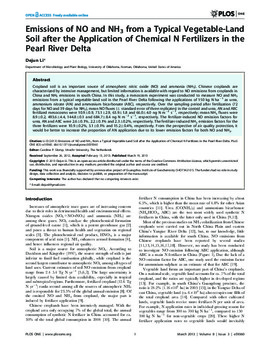| dc.contributor.author | Dejun Li | en_US |
| dc.date.accessioned | 2015-01-23T17:17:44Z | |
| dc.date.accessioned | 2016-03-30T15:31:10Z | |
| dc.date.available | 2015-01-23T17:17:44Z | |
| dc.date.available | 2016-03-30T15:31:10Z | |
| dc.date.issued | 2013-03-19 | en_US |
| dc.identifier.citation | Li D (2013) Emissions of NO and NH3 from a Typical Vegetable-Land Soil after the Application of Chemical N Fertilizers in the Pearl River Delta. PLoS ONE 8(3): e59360. doi:10.1371/journal.pone.0059360 | en_US |
| dc.identifier.uri | https://hdl.handle.net/11244/14091 | |
| dc.description | | en_US |
| dc.description | Conceived and designed the experiments: DL. Performed the experiments: DL. Analyzed the data: DL. Contributed reagents/materials/analysis tools: DL. Wrote the paper: DL. | en_US |
| dc.description.abstract | Cropland soil is an important source of atmospheric nitric oxide (NO) and ammonia (NH3). Chinese croplands are characterized by intensive management, but limited information is available with regard to NO emissions from croplands in China and NH3 emissions in south China. In this study, a mesocosm experiment was conducted to measure NO and NH3 emissions from a typical vegetable-land soil in the Pearl River Delta following the applications of 150 kg N ha−1 as urea, ammonium nitrate (AN) and ammonium bicarbonate (ABC), respectively. Over the sampling period after fertilization (72 days for NO and 39 days for NH3), mean NO fluxes (± standard error of three replicates) in the control and urea, AN and ABC fertilized mesocosms were 10.9±0.9, 73.1±2.9, 63.9±1.8 and 66.0±4.0 ng N m−2 s−1, respectively; mean NH3 fluxes were 8.9±0.2, 493.6±4.4, 144.8±0.1 and 684.7±8.4 ng N m−2 s−1, respectively. The fertilizer-induced NO emission factors for urea, AN and ABC were 2.6±0.1%, 2.2±0.1% and 2.3±0.2%, respectively. The fertilizer-induced NH3 emission factors for the three fertilizers were 10.9±0.2%, 3.1±0.1% and 15.2±0.4%, respectively. From the perspective of air quality protection, it would be better to increase the proportion of AN application due to its lower emission factors for both NO and NH3. | en_US |
| dc.language.iso | en_US | en_US |
| dc.publisher | PLos One | en_US |
| dc.relation.ispartofseries | PLoS ONE 8(3):e59360 | en_US |
| dc.relation.uri | http://www.plosone.org/article/info%3Adoi%2F10.1371%2Fjournal.pone.0059360 | en_US |
| dc.rights | Attribution 3.0 United States | en_US |
| dc.rights.uri | https://creativecommons.org/licenses/by/3.0/us/ | en_US |
| dc.subject | PLOS | en_US |
| dc.subject | Public Library of Science | en_US |
| dc.subject | Open Access | en_US |
| dc.subject | Open-Access | en_US |
| dc.subject | Science | en_US |
| dc.subject | Medicine | en_US |
| dc.subject | Biology | en_US |
| dc.subject | Research | en_US |
| dc.subject | Peer-review | en_US |
| dc.subject | Inclusive | en_US |
| dc.subject | Interdisciplinary | en_US |
| dc.subject | Ante-disciplinary | en_US |
| dc.subject | Physics | en_US |
| dc.subject | Chemistry | en_US |
| dc.subject | Engineering | en_US |
| dc.title | Emissions of NO and NH3 from a Typical Vegetable-Land Soil after the Application of Chemical N Fertilizers in the Pearl River Delta | en_US |
| dc.type | Research Article | en_US |
| dc.description.peerreview | Yes | en_US |
| dc.description.peerreviewnotes | http://www.plosone.org/static/editorial#peer | en_US |
| dc.identifier.doi | 10.1371/journal.pone.0059360 | en_US |
| dc.rights.requestable | false | en_US |

